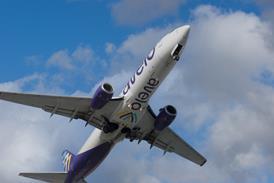Airbus's catalogue for the A350 XWB is taking shape, with the airframer having completed the selection on the majority of suppliers for its initial book.
"Most of the work packages for the cabin are on board and we are in the middle of the joint definition phase. Most of them are even being finalised so they start the detailed design by the end of this year," says head of A350 XWB product offering Alexander Herkner.
For supplier furnished equipment (SFE), such as lavatories and galleys, Airbus is taking a modular customisation approach. Galley inserts follow Arinc standards for flexibility and ease in exchanging equipment.
For in-flight entertainment and connectivity, the airframer is largely forgoing a traditional buyer furnished equipment (BFE) approach. Instead, it has designated an 'Airbus contracted supplier' (ACS) category for these items to ensure suppliers participate in the joint definition phase of the programme and understand the design language of the cabin early on.
To date, Airbus has signed ACS deals with B/E Aerospace, Recaro and Zodiac Group unit Weber Aircraft for the provision of economy-class seats; and EADS Sogerma for premium-class seats.
"The initial offering should be three economy-class products and three business-class products," says Herkner, noting that the airframer "intends to add two more products" to the premium segment.
Additionally, he says, to offer "more differentiation" in the premium cabin, airlines are permitted to "go for a classical BFE approach". However, this can only be arranged with one of the ACS suppliers and is limited to premium seats.
For in-flight entertainment, airlines can choose hardware from Panasonic Avionics or Thales. An ACS agreement has already been signed with the former, and Herkner says a deal with Thales is in the process of being finalised.
Carriers that select Panasonic IFE hardware will be offered a choice of two in-flight connectivity solutions. The first comprises Panasonic's own connectivity platform for Ku-band satellite-based high-speed Internet plus mobile connectivity courtesy of partner AeroMobile. The second entails Airbus' Airline Network Architecture version 2 (ALNA V2), a modular connectivity platform that uses the Inmarsat SwiftBroadband (SBB) aeronautical service over L-band satellites and supports mobile connectivity and Wi-Fi services from Airbus/SITA joint venture OnAir.

Theoretically, says Herkner, additional in-flight entertainment and connectivity solutions could be offered in the future. He notes that Airbus is also looking for more standardisation on the integration of IFE into seats, and this can be optimised under the ACS process.
By employing a more modular approach in the cabin, and avoiding a lot of complex engineering work after an airline has placed its order, Airbus believes it can shave at least four months off the lead time that an airline needs to decide on customising its A350s.
On current programmes, airlines need to make catalogue choices approximately one year before delivery and then there is still a lot of engineering work. "So what we want to achieve here is to shorten his time. We have a vision to go to something like eight months," says Herkner. If airlines freeze their configurations at a later point, it also means less working capital for Airbus, adds A350 programme manager Didier Evrard.
See Mary Kirby's Runway Girl blog for more information about the A350 catalogue.
Source: Air Transport Intelligence news























